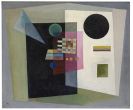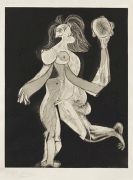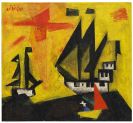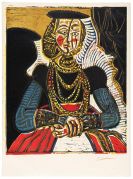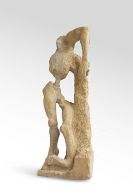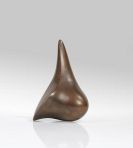
Georges Braque
Argenteuil
1882 -
Paris
1963
Georges Braque was born in Argenteuil on May 13, 1882. The family moves to Le Havre in 1890 where the young boy has his first encounters with paint and brushes in his father's painting business. He attends lectures at the Le Havre Art Academy as of 1899, a short time later he starts to work for a decoration painter. Georges Braque goes to Paris in 1900, and continues his apprenticeship as a decoration painter, he attends drawing classes at the school of Batignolles, followed by studying at the Académie Humbert.
Georges Braque sees works of the "Fauves" in the Salon d'Automne in 1905, which impress him so much that he takes on their bright colours in his works. He spends the fall of 1906 painting in L'Estaque, in the footsteps of Paul Cézanne, whose paintings he also admires. Together with the "Fauves", he exhibits in the Salon des Indépendants in 1907. He spends the summer and the fall of this year in L'Estaque again. It is also in 1907 that he meets Pablo Picasso, encountering his painting "Les Demoiselles d'Avignon". A close friendship between Georges Braque and Pablo Picasso begins, in their artistic co-operation and especially by closely examining the art of Paul Cézanne, they develop the Cubist style of painting. They exhibit in the gallery of Daniel-Henry Kahnweiler in Paris in 1908.
Braque's and Picasso's close co-operation lasts until 1914, some works from this period of "analytic Cubism" (1909-1912) are hard to clearly ascribe to one or the other artist, their painting becomes more and more abstract. Georges Braque adds letters to his pictures, drawn labels or Trompe-l'oeil effects, a technique that is then also taken on by Picasso. The period of "synthetic Cubism" follows as of 1912, a period during which Braque makes paper collages, the "Papiers collés", which are again taken on and developed by Picasso. They integrate other materials such as paper, wood, or sand into their paintings.
Georges Braque serves in World War I, he suffers a severe head injury followed by a long period of convalescence. He only picks up painting again as of 1917, making works that he will only present in public as of 1923. He becomes detached from Cubism, his works undergoing permanent changes over the following time.
Besides paintings, Braque also creates an extensive graphic oeuvre as of 1912, making etchings, also in colors, lithographs and woodcuts. As of 1939 he begins to deal intensively with sculpting and pottery. He makes the "Stuio pictures" as of 1949.
Georges Braque dies in Paris on August 31, 1963.
Would you like to sell a work by Georges Braque?
Infos for seller
